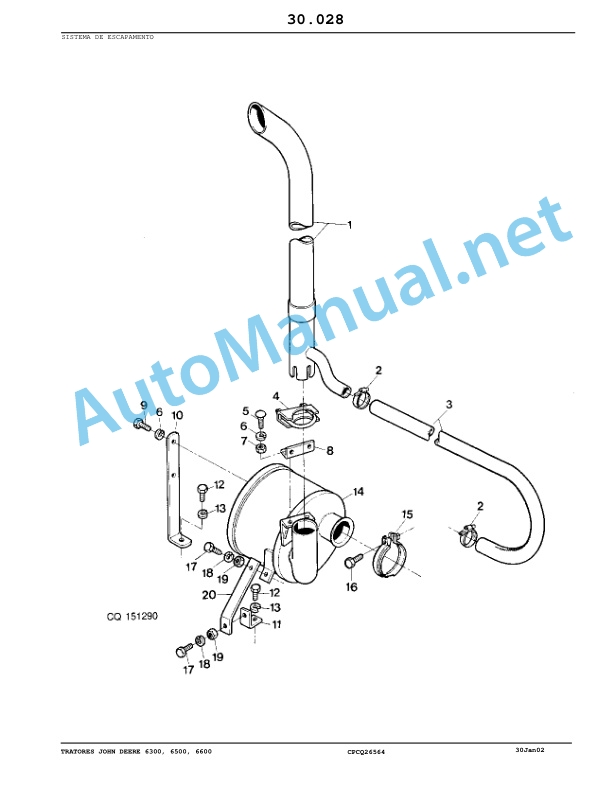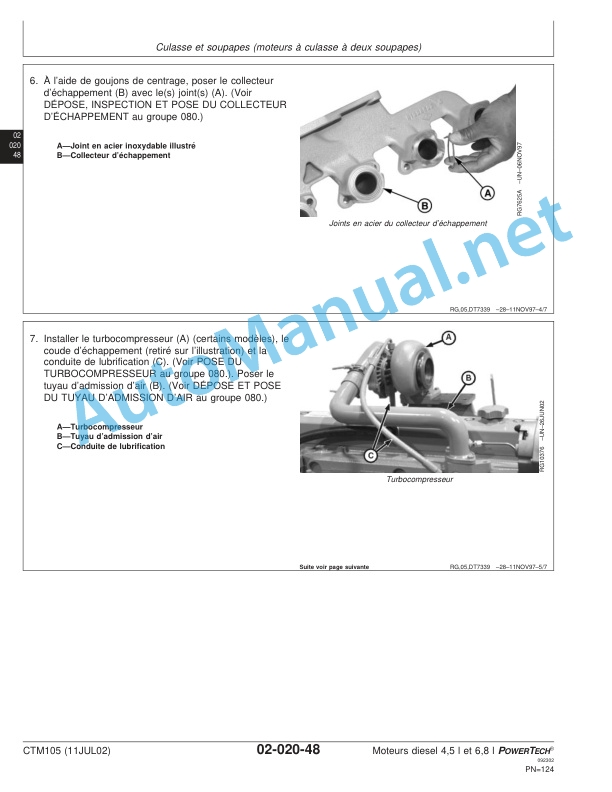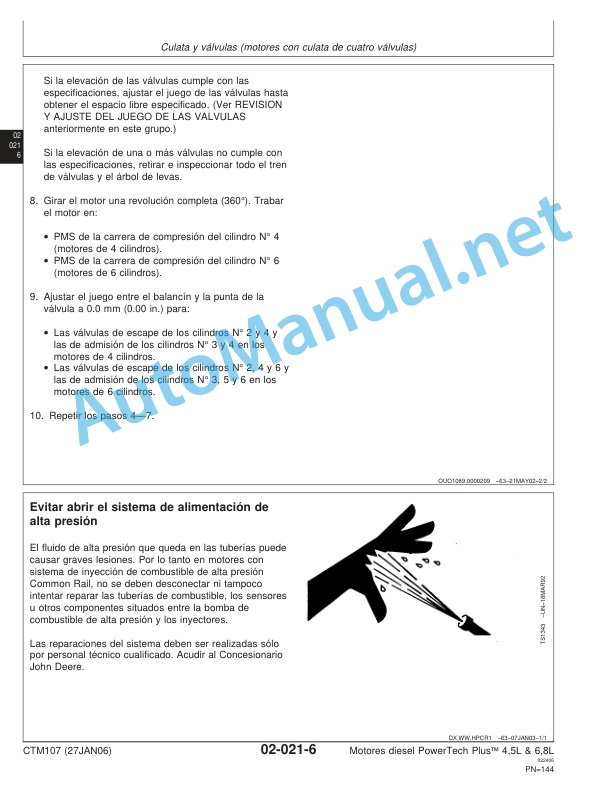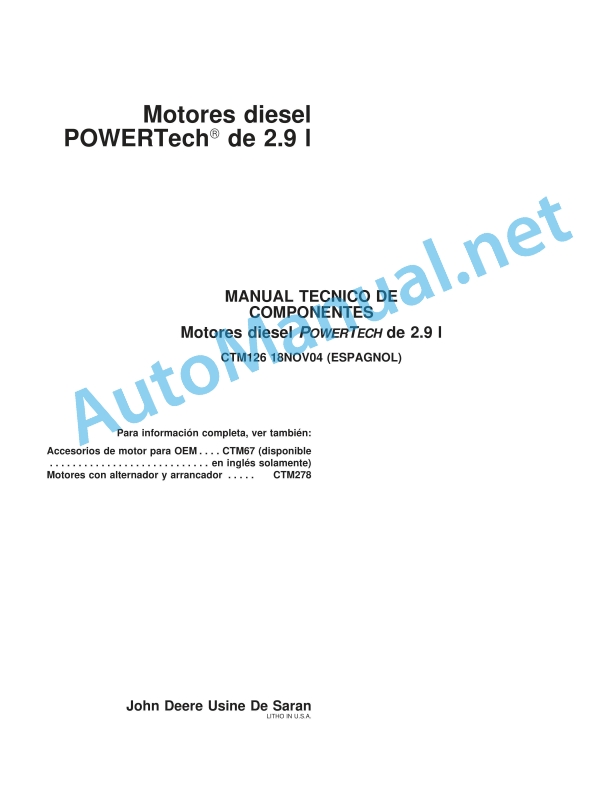Claas Nexos 250-210 Opencabin Stage 3B (A47) Tractors Operator Manual ES
$50.00
- Model: Nexos 250-210 Opencabin Stage 3B (A47) Tractors
- Type Of Manual: Operator Manual
- Language: ES
- Format: PDF(s)
- Size: 199 MB
File List:
00 1164 217 4.pdf
00 1164 217 4.pdf:
NEXOS VE 240/230/220/210NEXOS VL 250/240/230/220/210NEXOS F 250/240/230/220/210Stage 3B
1. Introduction
1.1 Information regarding the instruction manual
1.1.1 Validity of the user manual
1.1.2 Information about this user manual
1.1.3 Symbols and indications
1.1.4 Optional equipment
1.1.5 Qualified specialized workshop
1.1.6 Maintenance instructions
1.1.7 Information regarding warranty
1.1.8 Spare parts and technical questions
1.1.9 Transfer of the tractor to a third party
1.2 Proper application of the machine
1.2.1 Proper machine application
1.2.2 Logically foreseeable inappropriate application
2 Security
2.1 Recognize warning signs
2.1.1 Danger symbols
2.1.2 Keyword
2.2 Safety instructions
2.2.1 European regulations
2.2.2 Meaning of the user manual
2.2.3 Take into account and respect the warning pictograms on the tractor and the warnings in the manual
2.2.4 Requirements that must be met by all people who work with the tractor
2.2.5 Dangers for children
2.2.6 Position yourself between the tractor and the machine
2.2.7 Accompanying persons
2.2.8 Couple tractor with work device or trailer
2.2.9 Risk of injury in the power take-off area
2.2.10 Risk of injury in the cardan shaft area
2.2.11 Applications with front loaders
2.2.12 Avoid risks due to a front loader
2.2.13 Structural modifications
2.2.14 Optional equipment and spare parts
2.2.15 Forestry work
2.2.16 Control of the tractor in operation
2.2.17 Operation only after correct start-up
2.2.18 Technical status
2.2.19 Risks arising from damage to the tractor
2.2.20 Respect technical limit values
2.2.21 Risks derived from machine elements that continue to operate due to inertia
2.2.22 Keep protective devices operational
2.2.23 Personal protective equipment
2.2.24 Wear appropriate clothing
2.2.25 Clean dirt and remove loose objects
2.2.26 Prepare the tractor for road travel
2.2.27 Risks during road and countryside travel
2.2.28 Store the tractor safely
2.2.29 Unsuitable consumables
2.2.30 Safe handling of consumables and auxiliary materials
2.2.31 Fuel is harmful to health
2.2.32 Cooling agents are harmful to health
2.2.33 Environmental protection and waste disposal
2.2.34 Keep the cabin free of chemical materials
2.2.35 Handling of pesticides and fertilizers
2.2.36 Fire hazard
2.2.37 Deadly electrical discharge through overhead lines
2.2.38 Behavior in the case of an overhead line voltage transfer and lightning strike
2.2.39 Electrical shock from electrical equipment
2.2.40 Noise can harm health
2.2.41 Vibrations can harm health
2.2.42 Liquids under pressure
2.2.43 Pressurized air
2.2.44 Toxic exhaust gases
2.2.45 Hot surfaces
2.2.46 Getting on and off safely
2.2.47 Work must be carried out only with the tractor stopped
2.2.48 Maintenance and repair work
2.2.49 Raised tractor elements and loads
2.2.50 Risks related to welding work
2.2.51 Check the battery and charge it
2.3 Safety marking on the tractor
2.3.1 General advice regarding safety markings
2.3.2 Warning symbols
2.4 Safety devices
2.4.1 Wheel chock
3 Description of the tractor
3.1 Overview
3.1.1 Right front view
Platform version
Cabin version
3.1.2 Left rear view
Platform version
Cabin version
3.1.3 Category 4 filtration overview
3.2 Identification plates and vehicle identification number
3.2.1 Tractor nameplate
Tractor identification number
Regulatory tractor type
Tractor serial number
3.2.2 Tractor power label
3.2.3 Motor nameplate
3.2.4 Transmission nameplate
3.2.5 Front axle nameplate
Four-wheel drive tractor with rigid front axle
Four-wheel drive tractor with suspended front axle
Two-wheel drive tractor
3.2.6 Cab or platform nameplate
3.3 Information on the tractor
3.3.1 Lifting points
3.3.2 Oil level indicator
3.3.3 Brake fluid
3.3.4 Power take-off regime
3.3.5 Engine cover
3.3.6 Disassembly of the side covers
3.3.7 Tractor lubrication
3.3.8 Rear lift
3.3.9 Rear distributor pressure taps
3.3.10 Front distributor pressure taps
3.3.11 Emergency exit
3.3.12 Cab category
Identification of air filter elements in category 3 operating mode
Identification of air filter elements in category 4 operating mode
4 Control and display instruments
4.1 Cabin
4.1.1 Driving position
Right side controls (tractor with electronic lift and electrohydraulic distributors)
Right side controls (tractor with electronic lift and mechanical control hydraulic distributors)
Right side controls (tractor with mechanical lift and mechanical control hydraulic distributors)
Left side controls
Category 4 filtration controls
4.1.2 Dashboard
Tractor with mechanical inverter
Tractor with low torque inverter
Control panel switches
4.1.3 Controls on the right pillar
4.1.4 Cabin top controls
Heating, ventilation and air conditioning controls
rear wiper
Roof light
Car radio (pre-equipment)
4.1.5 Access and glass
Right and left doors
Openable tailgate
Openable windshield
Sunshade curtain
4.2 Driver’s platform
4.2.1 Work light controls
4.3 Control and display instruments
4.3.1 Instrument panel
4.3.2 Digital display
4.3.3 Electronic elevator controls
4.3.4 Rear mechanical linkage controls
4.4 Hydraulic installation
4.4.1 Hydraulic controls
Front lift
Conversion of double-acting/single-acting auxiliary hydraulic distributors
4.5 Electrical and electronic system
4.5.1 Key contactor
4.5.2 Control lever for signal lights and acoustic warning
4.5.3 External controls
Mechanical rear hydraulic lift
Electrohydraulic rear lift
4.5.4 Electrical power socket
4.6 Assembled parts and machine casing
4.6.1 Viewer
4.6.2 Toolbox
4.6.3 Fixing the boxes in the cabin
5 Technical data
5.1 NEXUS
5.1.1 Dimensions
Cabin version
Platform version
5.1.2 Weight
Cabin version (two-wheel drive)
Cab version (four-wheel drive)
Platform version (two-wheel drive)
Platform version (four-wheel drive)
5.1.3 Engine
5.1.4 Gearbox
mechanical transmission
Electrohydraulic transmission
5.1.5 Travel speeds
5.1.6 Without duplicator and 12/12 gearbox – 30 km/h version
5.1.7 Mechanical reverser or mechanical or electrohydraulic duplicator and 24/24 gearbox. 40 km/h version
5.1.8 Electrohydraulic reverser and electrohydraulic duplicator and 24/12 gearbox. 40 km/h version
5.1.9 Electrohydraulic reverser and mechanical duplicator and 24/24 gearbox. 40 km/h version
5.1.10 Front axle (two-wheel drive)
CARRARO front axle 373788
5.1.11 Engine front axle (four-wheel drive)
Rigid front axle
Suspended front axle
Synchronism ratio
VE NEXUS
NEXOS VL
5.1.12 Rear axle
5.1.13 NEXOS VE: Front track table
Front axle (Four-wheel drive version)
Non-reinforced variable disc rim
Reinforced variable disc rim
Fixed disc rim
Front axle (two-wheel drive version)
5.1.14 NEXOS VE: Rear track table
5.1.15 NEXOS VL: Front track table
Front axle (Four-wheel drive version)
Non-reinforced variable disc rim
Reinforced variable disc rim
Fixed disc rim
Front axle (two-wheel drive version)
5.1.16 NEXOS VL: Rear track table
5.1.17 NEXOS F: Front track table
Front axle (Four-wheel drive version)
Non-reinforced variable disc rim
Reinforced variable disc rim
Fixed disc rim
Front axle (two-wheel drive version)
5.1.18 NEXOS F: Rear track table
5.1.19 Tire combinations
VE NEXUS
NEXOS VL
NEXOS VF
5.1.20 Tire characteristics
5.1.21 Brakes
5.1.22 Address
5.1.23 Rear linkage
5.1.24 Front linkage
5.1.25 Rear hitches
5.1.26 Rear PTO
5.1.27 Front power take-off
5.1.28 Hydraulic circuits
Open central circuit 60 l/min
Open central circuit 85 l/min
5.1.29 Auxiliary Hydraulic Distributor Combinations
Auxiliary hydraulic distributors
Circuit 60 l/min
Circuit 85 l/min
Auxiliary electrohydraulic distributors
Circuit 85 l/min
5.1.30 Electrical circuit
5.1.31 Noise level
Noise level in the driver’s ears (according to European directive 2009/76)
Noise level in the ears of a passerby (according to European directive 2009/63 Annex VI)
5.1.32 Seat vibration level
5.1.33 Ballast
Four-wheel drive tractors
Two-wheel drive tractors
5.1.34 Maximum allowable towable masses
Two-wheel drive version
Four-wheel drive version
5.1.35 Load capacities
5.1.36 Cabin protection level
5.2 Inputs
5.2.1 Lubricants/Hydraulic oils
5.2.2 Engine coolant
5.2.3 Brake fluid
5.2.4 Air conditioning circuit
6 Prepare the tractor
6.1 Securing the tractor
6.1.1 Stop the tractor and secure it
6.1.2 Put the tractor in safety position
6.2 Perform before commissioning
6.2.1 Preparation for the first start-up
6.2.2 Preparation for commissioning
6.2.3 Hitching and connecting the implement
6.3 Engine
6.3.1 Fuel
Quality requirement
Particularities of biofuels
Fuel handling
6.3.2 Fill the fuel tank
6.4 Framework
6.4.1 Track adjustment
Track adjustment method
6.4.2 Adjustment of the rotation stops
Verification
Adjustment
6.4.3 General characteristics of the tires
6.4.4 Inflation pressure
Effect on soil compaction
Effect on consumption
6.4.5 Features
Load index
speed index
6.5 Brake
6.5.1 Brake pedal engagement
6.5.2 Hydraulic trailer brake
6.6 Address
6.6.1 Steering column
6.7 Rear linkage
6.7.1 Lifting supports
6.7.2 Upper connecting rod
6.7.3 Stabilizers
NEXUS VE – VL
6.7.4 Hydraulic vertical tie rod (without option of stabilizers and hydraulic reach)
6.7.5 Hydraulic vertical tie rod, stabilizers and hydraulic reach
6.7.6 Automatic hooks
6.7.7 External controls
Mechanical lifting
Hydraulic lifting
6.7.8 Hitching and unhitching an implement
Hitch Recommendations
Disengagement
6.8 Front linkage
6.8.1 Placing the plugs in the pressure taps
6.8.2 Conversion of the front linkage into single-acting/double-acting
6.8.3 Front linkage lock
6.8.4 Upper connecting rod
6.8.5 Lower cranks
6.8.6 Automatic hooks
6.8.7 Hitching/unhitching an implement
Hitch Recommendations
Disengagement
6.9 Rear PTO
6.9.1 Hitching and unhitching an implement
Connecting and disconnecting the rear power take-off cardan
Disengagement
6.10 Towing device
6.10.1 Recommendations
6.10.2 Calculation of maximum towable load (not including CUNA forks)
6.10.3 Hitch forks
6.10.4 Oscillating bar
Tightening of the jaw
Safety device
6.10.5 Pull hook
6.11 Rear hydraulic system
6.11.1 Rear pressure taps
Connection/Disconnection of pressure taps
Free return to deposit
6.11.2 Single acting/double acting adjustment
6.12 Front hydraulic system
6.12.1 Front pressure points
Connection/Disconnection of pressure taps
Free return to deposit
6.12.2 Lateral pressure taps
Connection/Disconnection of pressure taps
6.13 Electrical and electronic system
6.13.1 Electrical sockets
Trailer or tool lighting socket
Electrical power outlet
6.13.2 Low beam adjustment
6.14 Cabin and driving position
6.14.1 Mirror adjustment
Cabin version
Telescopic mirrors (depending on option)
Interior mirror
Platform version
6.14.2 Folding arch
6.14.3 Driver’s seat adjustment
6.14.4 Cable routing
6.14.5 Compartments
6.14.6 Category 2 filter
6.14.7 Category 4 filtration module
Mode of operation in category 3
Mode of operation in category 4
Transition from category 4 (or 3) operating mode to category 2 operating mode
6.15 Assembly and body parts
6.15.1 Ballast
6.15.2 Balancing the tractor with mounted tools
Summary table
6.15.3 Assembly and disassembly of the front masses
6.15.4 Opening and closing of covers
Monobloc cover
Opening the engine cover
Engine cover closure
Side covers
Removal of the main side covers
Installing the side hoods
Right side cover
Removing the right side cover
Installing the right side hood
6.15.5 Front fixing points
6.15.6 Additional racks
Front additional frame
Additional side frame (tractor not equipped with a front linkage)
Additional side frame (tractor equipped with a front linkage)
6.16 Tractor transport
6.16.1 Transport
7 Management
7.1 Driving and transportation
7.1.1 Preparation of the road itinerary
7.1.2 Preparation of the field itinerary
7.1.3 Driving with implements
Difficult pulling jobs
7.2 Engine
7.2.1 Break-in
7.2.2 Engine starting
Preliminary operations
Start up
7.2.3 Accelerator pedal
7.2.4 Hand throttle
7.2.5 Engine speed memories
Activation of an engine speed memory
Manual adjustment of engine speed memories (method 1)
Manual adjustment of engine speed memories (method 2)
7.2.6 Particle filter
Particulate filter filling percentage
Scorecard
Operating logic
Automatic particulate filter regeneration
Regeneration of the particulate filter when stopped
Maintenance regeneration
Particulate filter replacement
7.2.7 Engine stop
7.3 Transmission, clutch and cardan shaft
7.3.1 Neutral position of the reverse gear
Tractors with mechanical inverter
Tractors with low torque inverter (electrohydraulic)
7.3.2 Put the transmission in neutral position
7.3.3 Selection of tractor forward direction
recommendations
Tractors with mechanical inverter
Tractors with low torque inverter (electrohydraulic)
7.3.4 Clutch
Advance pedal
contactor
7.3.5 Speed selection
7.3.6 Range selection
7.3.7 Range duplicator
Mechanical range duplicator
Electrohydraulic range duplicator
7.3.8 Differential lock
7.4 Chassis
7.4.1 Front axle activation
General characteristics
Automatic mode
Utilization
Functioning
Permanent mode
Utilization
Functioning
Automation depending on the angle of rotation
Utilization
Functioning
Automation angle configuration
7.4.2 Front axle suspension
Front axle suspension activation switch
Front axle height adjustment potentiometer
Suspension activationir light
Front axle suspension activation
Automatic mode
Manual mode
Locked mode
7.5 Brake
7.5.1 Service brakes
7.5.2 Handbrake (auxiliary and parking brake)
7.6 Mechanical rear hydraulic lift
7.6.1 Position control
7.6.2 Effort control
7.6.3 Mixed control
7.6.4 Floating hitch
7.6.5 Sensitivity adjustment
7.6.6 External controls
7.7 Electronic rear hydraulic lift
7.7.1 Safety indicator
7.7.2 Transport security
7.7.3 Lift start-up
7.7.4 Mode selection
7.7.5 Position check
7.7.6 Effort control
7.7.7 Upper stop
7.7.8 Descent speed
7.7.9 Quick ground function
7.7.10 External controls
7.8 Front linkage
7.8.1 Use
Mechanical control distributor
Electrohydraulic distributor
7.9 Rear PTO
7.9.1 PTO speed selection
Selection of power take-off regime proportional to the advance
7.9.2 Use
Assisted mechanical activation power take-off
PTO with electrohydraulic start
7.9.3 Work in fixed position
7.10 Front power take-off
7.10.1 Use
Activation of the front power take-off
7.10.2 Work in fixed position
7.11 Rear hydraulic system
7.11.1 Rear controls and pressure taps
Auxiliary hydraulic distributors with mechanical control
Electrohydraulic Auxiliary Hydraulic Distributors
7.11.2 Auxiliary hydraulic distributors with mechanical control
7.11.3 Auxiliary electrohydraulic distributors
Controls
Start up
Online controls
Pressure position
floating position
Hydraulic timer
Cross control
floating position
Additional functions
7.11.4 Hydraulic timer
7.11.5 Adjustment of flow rates
Hydraulic distributors with mechanical control
Distributors with flow regulator in the center
Distributors with flow divider in low position
Electrohydraulic distributors
7.11.6 Work in fixed position
7.12 Front hydraulic system
7.12.1 Front controls and pressure taps
Auxiliary hydraulic distributors with mechanical control
Electrohydraulic Auxiliary Hydraulic Distributors
7.12.2 Controls and lateral pressure taps
Mechanical control auxiliary hydraulic distributors without duplicator
Mechanical Control Auxiliary Hydraulic Distributors with Duplicator
Electrohydraulic auxiliary hydraulic distributors without duplicator
Electrohydraulic auxiliary hydraulic distributors with duplicator
7.13 Electrical and electronic system
7.13.1 Manual circuit breaker and external positive terminal
7.14 Cabin and driving position
7.14.1 Instrument panel display
Screen information menu
Available data:
Usage menu
Particulate filter (DPF)
Language
Measurement units
Transmission errors
Engine errors
Tire speed code
Front PTO Ratio
Exit the user menu
7.14.2 Manual air conditioning control
Windshield defrosting
7.14.3 Category 2 filtration system
7.14.4 Category 4 filtration system
Must be done before start-up
Start up
8 Incident and solution
8.1 Alarms
8.1.1 Operating anomalies
Viewing error codes
8.1.2 Primary alarms
8.1.3 Secondary alarms
8.1.4 Other alarms
8.1.5 Category 4 filtration module operating anomaly
8.1.6 Suspended front axle operating anomaly
8.1.7 Overview of filtration system faults
8.1.8 Steps to resolve various anomalies
8.2 Engine
8.2.1 Failure due to lack of fuel
8.3 Framework
8.3.1 Jack placement
8.3.2 Changing a wheel
8.3.3 Tractor trailer
Trailer with engine running
Trailer with engine off
towing forks
8.3.4 Unclogging the tractor
Tractor unclogging
Unclogging a tractor by towing
8.4 Electrical and electronic system
8.4.1 Fuses and relays
Main fuse and relay box
Tractor with mechanical inverter
Tractor with hydraulic reverser
Right pillar fuse box
Left pillar fuses and relays
Left pillar fuses and relays
Fuse and relay box on the front of the engine
Electrohydraulic distributor fuse and relay box
Battery relays and fuses
Cabin version
Platform version
Category 4 filtration module relays and fuses
Front axle suspension relays and fuses
8.4.2 Lights overview
9 Maintenance
9.1 Maintenance instructions
9.1.1 Personal protective equipment
9.1.2 Use according to assignment
9.1.3 Shutting down the engine and securing the tractor
9.1.4 Clean and organize risk areas
9.1.5 Welding instructions
9.1.6 Protection devices on the tractor
9.1.7 Engine
Alternator
Engine lubrication
engine cooling
engine belts
9.1.8 Wheels and tires
9.1.9 Braking system
9.1.10 Address
9.1.11 Power take-off driven tools
9.1.12 Air conditioning
9.1.13 Hydraulic circuit
9.1.14 Electrical system
9.1.15 Energy accumulators
9.1.16 Spare parts
9.1.17 Cleaning and protection
9.1.18 Work at height
9.1.19 Handling of heavy parts
9.1.20 Maintenance operations under the cabin or platform
9.1.21 Lifting the front of the tractor
9.2 Summary of maintenance intervals
9.2.1 According to the national legislation in force in the country of circulation of the tractor
9.2.2 First 10 hours of service
9.2.3 First 40 hours of service
9.2.4 First 100 hours of service
9.2.5 First 600 hours
9.2.6 Every 10 hours of service
9.2.7 Every 600 hours of service
9.2.8 Every 1200 hours of service
9.2.9 Every 2400 hours of service
9.2.10 Every 3 months
9.2.11 Semi-annually
9.2.12 Every 2 years
9.3 Greasing scheme
9.3.1 Greasing points – 20 h
9.3.2 Grease points, 100 h
Tractors with rigid front axle
Tractors with suspended front axle
9.3.3 Grease points, 500 h
Tractor with suspended front axle
9.3.4 Grease points – 1000 h
9.4 Engine maintenance operations
9.4.1 Change the fuel filter
9.4.2 Purging the water present in the fuel decanter pre-filter
9.4.3 Bleeding air from the injection circuit
9.4.4 Check the engine oil level
9.4.5 Change engine oil
Instrument panel reset
9.4.6 Replacing the engine oil filter cartridge
9.4.7 Replacing the oil vapor recycling filter
9.4.8 Check the coolant level
9.4.9 Check the tightness of the cooling circuit
9.4.10 Clean the refrigerators
9.4.11 Check the alternator and engine water pump belt
9.4.12 Replace the alternator belt and engine water pump
Removal and installation of the alternator belt
Assembly diagram
Disassembly
Mounting
9.4.13 Clean the engine air filter
9.4.14 Change the engine air filter
9.4.15 Replacing the engine air filter safety cartridge
9.4.16 Check the tightness of the air intake
9.5 Gear maintenance operations
9.5.1 Checking the clutch pedal play
9.5.2 Forward clutch clearance adjustment (depending on equipment)
9.6 Chassis maintenance work
9.6.1 Change the oil in the front axle final reductions
Tractor with rigid front axle
Tractor with suspended front axle
9.6.2 Checking the front axle differential case oil level
Tractor with rigid front axle
Tractor with suspended front axle
9.6.3 Change the oil in the front axle differential casing
Tractor with rigid front axle
Tractor with suspended front axle
9.6.4 Change the front axle breather
Tractor with rigid front axle
Tractor with suspended front axle
9.6.5 Check the tightness of the wheel discs on the hubs.
9.6.6 Check the tightness of the wheel discs on the rims
9.6.7 Check the condition of the wheels, tires and tire inflation pressure
9.7 Brake maintenance operations
9.7.1 Checking the service brake fluid level
9.7.2 Changing the braking circuit reservoir cap
9.8 Hitch device maintenance operations
9.8.1 Checking the fork clearances
9.9 Front power take-off maintenance operations
9.9.1 Replacing the front power take-off housing filter
9.9.2 Replacing the oil in the front power take-off box
9.10 Rear power take-off maintenance operations
9.10.1 Checking the power take-off clutch clearance
9.11 Hydraulic installation maintenance work
9.11.1 Checking the oil level of the hydraulic circuit and transmission
9.11.2 Replacing the hydraulic circuit and transmission oil
9.11.3 Replacing the filter cartridges of the hydraulic circuit and transmission
9.11.4 Replacing the hydraulic shower head
9.11.5 Check the hydraulic circuit.
9.12 Electrical/electronic installation maintenance work
9.12.1 Clean and grease the battery terminals
9.12.2 Checking the operation and condition of lighting and signaling devices
9.13 Cabin/driving position maintenance operations
9.13.1 Checking the windshield washer fluid level
9.13.2 Clean the cabin air filter
9.13.3 Clean the category 4 filtration system
Perform a visual check of the filtration system
9.13.4 Replacing the cabin air filter
9.13.5 Replace the filters of the category 4 filtration module
Perform a visual check of the filtration system
9.13.6 Cleaning the air conditioning condenser
9.13.7 Start the air conditioning
9.14 Bodywork maintenance operations
9.14.1 Check the tightening of the front mass fixing screws
9.14.2 Cleaning the calender grates
9.15 Parking
9.15.1 Parking instructions
Long term parking
New tractor commissioning
10 Decommissioning and waste disposal
10.1 Information about the machine
10.1.1 Disposal and waste disposal
11 Technical dictionary and abbreviations
11.1 Technical dictionary and abbreviations
11.1.1 Technical terms
11.1.2 Abbreviations
John Deere Parts Catalog PDF
John Deere Tractors 6300, 6500, and 6600 Parts Catalog CQ26564 (29SET05) Portuguese
John Deere Repair Technical Manual PDF
John Deere Repair Technical Manual PDF
John Deere Repair Technical Manual PDF
John Deere Repair Technical Manual PDF
John Deere Repair Technical Manual PDF
John Deere Diesel Engines POWERTECH 2.9 L Component Technical Manual CTM126 Spanish
John Deere Repair Technical Manual PDF
John Deere DF Series 150 and 250 Transmissions (ANALOG) Component Technical Manual CTM147 05JUN98






















